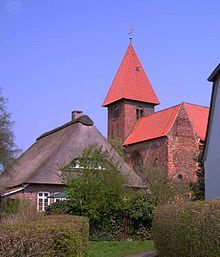St. Marien Monastery Church (Osterholz)
The St. Marien monastery church in Osterholz-Scharmbeck , Osterholz district (Osterholz district ) was built in the 12th century as a basilica in Romanesque style. Together with the 1562-built community center serves the Lutheran church St. Marien in Hanover Sprengel Stade as a church and meeting place.
history
The monastery (im) Osterholz was founded in 1182 by Archbishop Siegfried I of Anhalt from Bremen . His successor Hartwig II von Utlede transferred the patronage of the parish in Scharmbeck to the monastery in 1185 . The actual construction was organized until 1184 by Provost Eylhard, a monk of the Benedictine monastery of St. Paul in front of Bremen .
The monastery was consecrated to the Virgin Mary in 1197 and enfeoffed with the Börde Scharmbeck. This right to enfeoff represented a kind of “licensing” of the monastery by Rome, which the Pope underpinned in 1507 with the recognition of Johann Widdenbrücke as provost of the monastery. The monastery initially appears to have been a double monastery for men and women, but from 1202 it was only referred to as a nunnery .
The Börde Scharmbeck has long been subject to tax, but there were always disagreements with the lords of the (later) Sandbeck estate . Therefore in 1513 the monastery was once again enfeoffed with the sand basins in an official act. On a Sunday ( Laetare ), the provost Johann Widdenbrügge therefore invited them to the monastery. The mayor of Bremen, Marten Heyenbroch , the lords of the warner von der Hude and the lords of the Cordt brothers appeared as witnesses . The Archbishop of Bremen thus emphasized who exercised secular power in the region; a refusal would have meant the beginning of a feud and the Sandbeckers would have probably lost their fiefdom, which is why Just von Sandbeck committed himself to the monastery in front of his entourage. However, this did not finally end the conflicts.
In 1515, Archbishop of Bremen, Christoph von Braunschweig-Lüneburg , who was also Bishop of Verden , plundered the monastery. Since Heinrich von Zütphen made the Lutheran doctrine known in Bremen as early as 1522 , the Reformation also spread in the Osterholz monastery. In 1537 there were Protestant and Catholic nuns in the monastery; In 1550 it finally became Lutheran. This took place against the background of the Schmalkaldic War , in which Emperor Charles V sent an army to northern Germany in 1547 to restore the status quo of Catholic rule. However, this largely failed, because the imperial troops were defeated in the Battle of Drakenburg in the north of Nienburg by the Count of Mansfeld and Charles V could no longer compensate for this defeat by another campaign in the north.
The monastery immediately received its first Lutheran provost and the neighboring church of St. Wil (l) had (i) in Scharmbeck was occupied by a Lutheran clergyman, as there was no longer any risk of imperial troops being billeted. In 1562 the also preserved parish hall was built.
When the Danes left northern Germany in 1626 during the Thirty Years' War and evacuated Stade , Catholic associations penetrated the Osterholzer Geest and the Protestant nuns of the monastery fled from the Pappenheimers on May 28, 1630 , as they devastated some farms in the region in 1629/30 had. As a result, the monastery was initially occupied by Catholics, but was again Protestant when the Swedes arrived in 1633.
On May 16, 1630, the monastery took stock: it had been plundered five times and the golden goblet for the service was lost.
In the Peace of Westphalia of 1648, Christine was awarded the territory between Bremen, Verden, Weser and Elbe by Sweden . Since the dioceses of Bremen and Verden were ceded as imperial fiefs, the abolition of the monastery in 1650 was a consequence of this peace.
Origin of the original name as Osterholz monastery
The name Osterholz occurs three times in the Bremen area, except for the place of this monastery also for the Bremen district Osterholz , a former village where the Kleine Wümme begins as the Holter Fleet, and for a hamlet above the Geestrand in the eastern municipality of the city of Syke .
There are essentially two theories about the origin of the term Osterholz. Both are identical in that they equate "-wood" with forest or wood .
The first thesis translates the prefix “Easter” as the direction of the compass. This is how the local researcher Georg von Roth sees it in 1718 . Since the forest originally reached as far as the marshy meadow area of the Hamme , the moors then took up around 1/3 of the area and the Osterholzer Geest had rather less forest from the start, the name eastern forest appears from the perspective of the Liastmona court, which was mentioned as a royal fief in 860 understandable to describe the forest as an important source of raw materials. The use of the trunks from the Osterholz forest has been proven for the monastery, the monastery itself probably stands on former forest floor, the remaining forest today is called "monastery wood".
The second thesis sees the origin of "Easter" derived from the Germanic goddess Ostara , whose existence is very controversial in Germanic mythology , and there is no archaeological or other evidence or evidence of sacrificial sites in the city and district for any of the Asian deities . In this respect, the Ostara thesis is on weak feet.
literature
- Hans-Heinrich Jarck (editor): Document book of the Osterholz monastery. 1162–1651 (= sources and studies on the history of Lower Saxony in the Middle Ages. 5 = publications of the Historical Commission for Lower Saxony and Bremen. 37). Lax, Hildesheim 1982, ISBN 3-7848-3014-5 .
Web links
- Description of Osterholz Monastery on the Lower Saxony monastery map of the Institute for Historical Research
Coordinates: 53 ° 13 ′ 27 ″ N , 8 ° 48 ′ 45 ″ E

